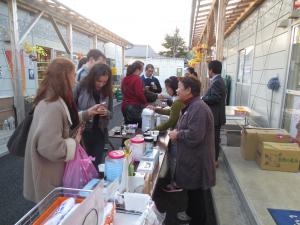A few times I have been asked by locals “weren’t you afraid to come to Fukushima?” The truth is I was. Undeniably, it helped that where I am based is closer to the West coast than the East coast. But the question flashed up a twinge of guilt. I made the choice to make this my home, albeit temporary; the people who asked me the question didn’t. And probably I would have decided otherwise had I been placed further east. It also brought to my attention that the people here are fully aware of the negative reputation that Fukushima has overseas. So when in November the opportunity came up to travel to the East coast as part of the weekend-long, whirlwind JET Study Tour, I suppose I felt deepening my understanding of the area was the right thing to do. The aim was to provide an insight into the recovery measures taking place in Iwaki. Time was tight and there was plenty to see, but I did pick up something meaningful. Help is still needed. The horrifying pictures beamed around the globe of when the tsunami struck and the devastation left behind are difficult to forget. But the media is fickle and yesterday’s news is old news, so I’ll admit I was taken aback to see the fishing town of Hisanohama still in ruins. Walking down towards a shrine facing the sea, the floor tiles among the patchwork of foundations indicated over there was a bathroom, over there someone’s kitchen. Sure, work is being done - from where we stood we watched the diggers gradually moving the rubble to make way for a shopping mall, we were told - but rebuilding homes, lives and a community looked like a mammoth task. The importance of community spirit. Hisanohama is located 32km south of the Fukushima Daiichi Nuclear Plant. Consequently the town hasn’t only had to deal with the initial damage caused by the earthquake and tsunami. When the fishermen stopped being able to sell their catch, the shops closed down and many residents decided to leave. Those few who stayed were left with nowhere to shop. So they came together and set up a few stalls in the Elementary School grounds which became the temporary shopping area, Hamakaze Shotengai. I noted a barber shop, a sweet shop, a grocery store, and a sake store. Also, the town people craft items such as badges and charms to help raise funds for the area. Impact of reputational damage and the need to build local consumer confidence. While communities such as Hisanohama do their best to rebuild, their efforts are overshadowed by the nuclear plant which continues to make headlines. The fear of nuclear contaminated food is understandable and the resulting loss of consumer trust has hit the local agricultural industry hard. Fishermen have been forced to stop fishing, and farmers have abandoned their land. At the Kisen kamaboko factory we heard how overnight consumers stopped buying their fishcakes even though the fish used was sourced in the United States. A similar story was told at Tomato Land where the tomatoes are grown hydroponically (without soil) and inside protective greenhouses. Yet wholesalers would sell their tomatoes at dramatically reduced prices despite independent tests showing produce to be radiation-free. However, they say adversity brings opportunity, and we certainly witnessed that ethic being put into practice. At Kisen rather than distancing themselves from the Fukushima name as other companies have done, they have developed a high-quality product which they market as exclusively being available in the area. They also opted for disintermediation so they could focus on improving consumer trust directly while at the same time cutting out middleman costs. And it seems to be working, with local consumers paying a full price. Then there’s the Organic Cotton Farm Project which stepped in to prevent abandoned agricultural land from going to waste. The initiative involves renting the land from farmers for a few years and using the land to grow brown cotton in a way that doesn’t tax the land. With the help of 3500 volunteers, the funds raised are used to help revitalise the Iwaki area. But it’s not enough to tell people your local produce is safe. At the Fukushima Agricultural Technology Centre in Koriyama City, we were told about the efforts being made to ensure food safety, from soil screening to experimental cultivation to the radiation level testing of Fukushima produce. Tomato Land continues to send samples for screening on a monthly basis. Fukushima continues to struggle with the impact of the earthquake and invisible threat of radiation. Recovery is being made but help is still needed. In addition to the physical rebuild, emphasis was placed on the need to restore local trust in local produce. The lasting impression that was made in my brief encounter with the people of Iwaki is of their admirable courage and remarkable determination to look towards the future. |  |
| Summary |







